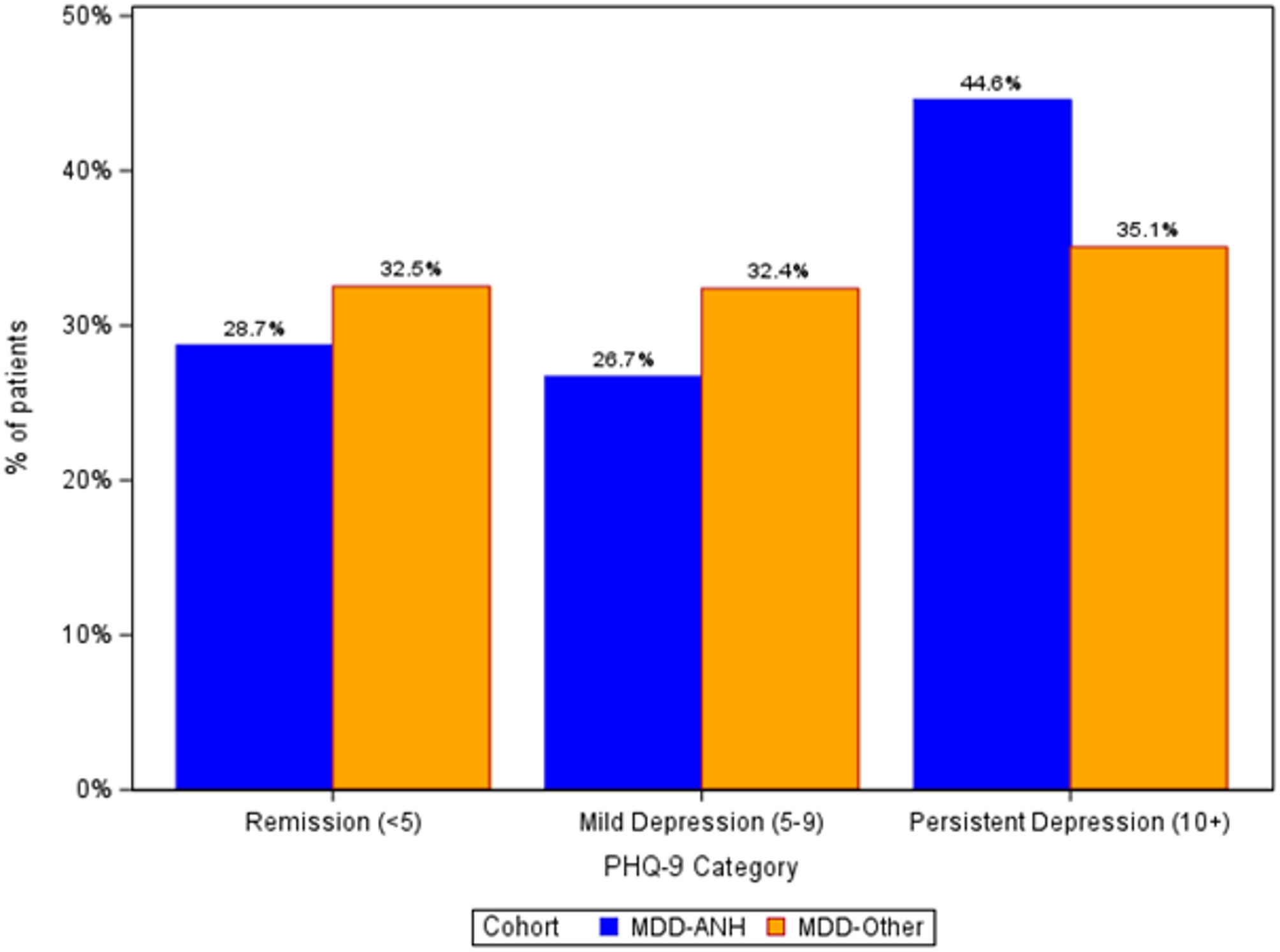Study sample
A total of 5,709 patients with MDD were assessed; 74.5% were in MDD-ANH and 25.5% were in the Other-MDD cohort (met criteria for MDD but not prominent anhedonia). Patient demographics and baseline characteristics during the 12-month baseline period are displayed in Table 1 for each of the two cohorts. The mean (SD) age in years was greater in the MDD-ANH (41.0, [SD = 15.8]) than the Other-MDD (37.8, [15.0], p < 0.001). A greater percentage of MDD-ANH patients had used Medicare (9.0% for MDD-ANH to 5.5% for Other-MDD, p < 0.001) or Medicaid (7.4% for MDD-ANH vs. 5.7% for Other-MDD, p = 0.033) for their most recent health care encounter prior to index. MDD-ANH patients tended to have more non-psychiatric baseline comorbidities compared to Other-MDD at any point prior to baseline. Mean (SD) of Charlson Comorbidity Index scores were greater among the MDD-ANH patients (0.6 [1.3]) compared to Other-MDD patients (0.5 [1.1], p = 0.020). There were no statistically significant differences in baseline psychiatric comorbidities between the MDD-ANH and Other-MDD groups, though the proportion of patients with ADHD was slightly lower in MDD-ANH (9.7%) compared to Other-MDD (11.3%).
The mean PHQ-9 score at the index date was higher among patients with MDD-ANH (18.2, SD = 4.2) compared to patients with Other-MDD (13.5, SD = 2.9) (Table 1). In addition, the last PHQ-9 score during follow-up was higher among patients with MDD-ANH (9.4, SD = 6.6) compared to patients with Other-MDD (8.1, SD = 5.8) (Table 1).
Analysis of antidepressant treatment patterns is presented in Table 2. In both cohorts, more than 80% of patients were treated with antidepressants and individual psychotherapy during follow-up. In the multivariable analyses, patients with MDD-ANH were more likely to have switched antidepressants (adjusted odds ratio [aOR] = 1.24, 95% CI: 1.07, 1.44, p = 0.004) and were more likely to have augmented antidepressant therapy (aOR = 1.16, 95% CI: 1.02, 1.31, p = 0.021) compared to the Other-MDD group.
The percentage of patients using different pharmacologic therapies at follow-up is presented in Table 2. After adjustment for baseline characteristics, patients with MDD-ANH were more likely to have been treated with SNRIs (aOR = 1.29, 95% CI: 1.13, 1.47, p < 0.001), tricyclic antidepressants (aOR = 1.31, 95% CI: 1.10, 1.56, p = 0.003), mood stabilizers (aOR = 1.32, 95% CI: 1.15, 1.51, p < 0.001), atypical antidepressants (aOR = 1.24, 95% CI: 1.09, 1.40, p < 0.001), and atypical antipsychotics (aOR = 1.51, 95% CI: 1.31, 1.74, p < 0.001) during the follow-up time period.
The percentages of patients in remission (PHQ-9 score < 5), with mild depression (PHQ-9 score 5–9), and patients with persistent depression (PHQ-9 score ≥ 10) by cohort is displayed in Fig. 1. By the end of the 12-month follow-up period, 28.7% of patients in the MDD-ANH achieved remission compared with 32.5% of MDD-Other patients. Persistent moderate to severe depression was present among 44.6% of MDD-ANH patients by end of follow-up compared to 35.1% of MDD-Other patients. After adjustment for baseline characteristics, when compared to the Other-MDD group, patients in the MDD-ANH cohort were significantly more likely to have persistent depression (aOR = 1.50, 95% CI; 1.32, 1.70, p < 0.001) and were significantly less likely to be in remission by the final PHQ-9 assessment (aOR = 0.82, 95% CI: 0.72, 0.94, p = 0.003) (Table 2).
Percentage Of Respondents in Remission, with Mild Depression, or Persistent Depression at Latest PHQ-9 Assessment in the 12 Month Follow Up Period
